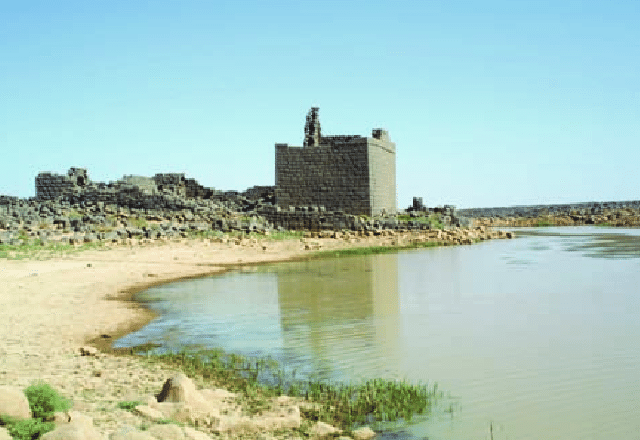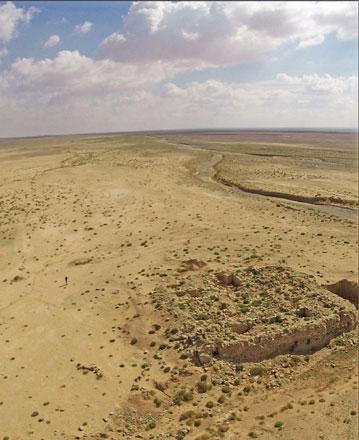You are here
German archaeological project traces early occupants of Qasr Burqu
By Saeb Rawashdeh - Dec 12,2022 - Last updated at Dec 12,2022

A pond in Qasr Burqu, in the Eastern Desert of Jordan (Photo courtesy of P. Viridis)
AMMAN — The current research project of the German Archaeological Institute (DAI) in and around Qasr Burqu, a set of archaeological ruins in eastern Jordan 243km east of Amman, focuses on the architectural ensemble in its geographical and temporal context, according to a German archaeologist.
The entire complex of the Qasr with the adjacent water reservoir and the dam in the Wadi Muqat is the subject of the research, said Claudia Buehring from the Oriental Department of the DAI
“Here, on the eastern bank of the wadi the master builders gradually erected the building ensemble of Qasr Burqu in with the adjacent reservoir. The focus of the research project is on the study of settlement activities and use of the environment over time in northeastern Badia during the transition from the 3rd to the 8th century AD,” Buehring told The Jordan Times in a recent interview.
The functionality and form of the building ensemble Qasr Burqu will be examined from a building history perspective, she said.
Special attention will be paid to the processes of change and adaptation that had an impact on the morphology of Qasr Burqu, she continued, adding that in October 2022 they started with the documentation of the building stock, the inscriptions and the graffiti of Qasr Burqu.
“In the research project, the functionality and form of this building ensemble was investigated from an architectural and historical point of view,“ Buehring said, adding that a first detailed construction documentation of the entire complex is now available — in the form of a 3D image.
She said that the project is carried out in cooperation with the Department of Antiquities.
In addition, there is a cooperation with the conservationists of the Royal Society for the Conservation of Nature (RSCN), she said.
Buehring noted that cooperation will be expanded, particularly with regard to environmental conditions, the use of resources, and the joint communication of cultural and natural heritage in Qasr Burqu and in the Burqu Nature Reserve.
However, the occupation of Qasr Burqu has not been determined yet. “We are at the beginning with the project,” she said.
Buehring said that so far, scholars cannot determine how many people lived there during the Roman Byzantine and the early Islamic periods.
“But what we can say is that water was available to the inhabitants. In Qasr Burqu there is the dam in the Wadi Muqat with the open reservoir and there is evidence of a cistern within the qasr. By means of these resources, one was able to provide water for the inhabitants and animals,” Buehring explained.
The Roman-Byzantine Burqu complex was used and expanded under the Umayyads, she said, noting that expansion measures are attributed to Al Walid, the son of Caliph Abd Al Malik.
“It is possible that the decline of Qasr Burqu is related to the power struggles around the middle of the 8th century between the Umayyads and the Abbasid followers. The result was a shift of the centre of power — from Damascus to Baghdad, but here we are, still at the beginning with our research,” Buehring concluded.
Related Articles
AMMAN — Qasr Mushash, located 40 kilometres east of Amman, was probably used for postal services during the Umayyad period, according to a G
AMMAN — The Royal Society for the Conservation of Nature (RSCN) has submitted the nomination of Burqu as a nature reserve to the Ministry of
AMMAN — Jordanian photographer Bashar Tabbah captivated the audience at the British Council for Research in the Levant (CBRL), with a “photo


















